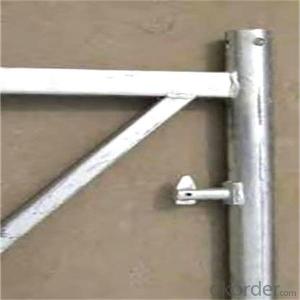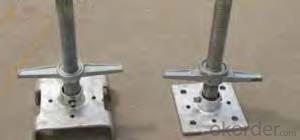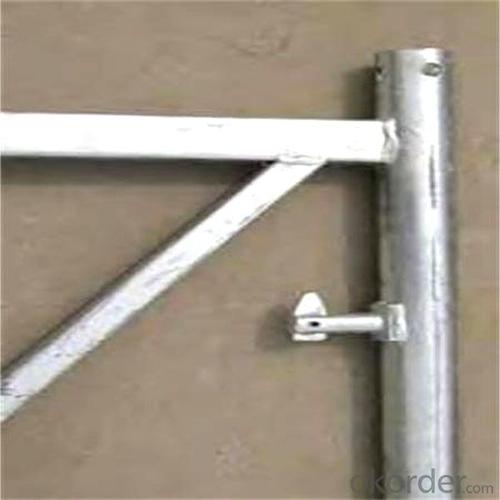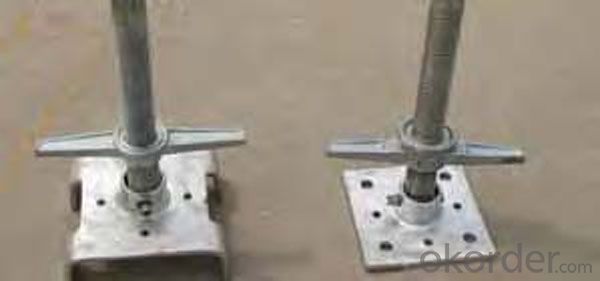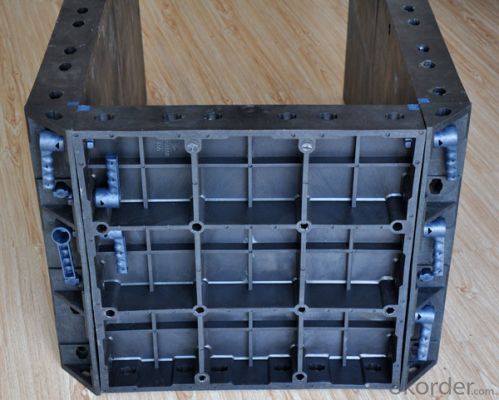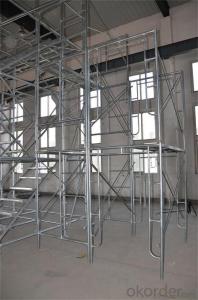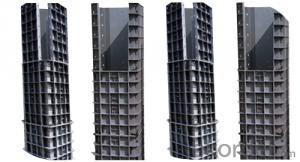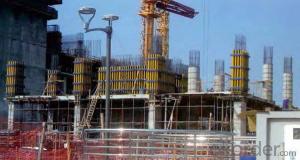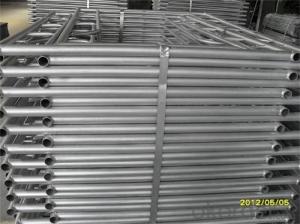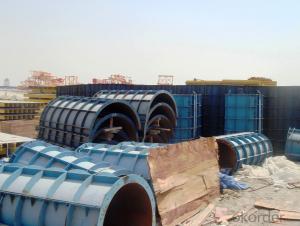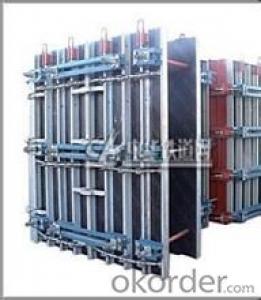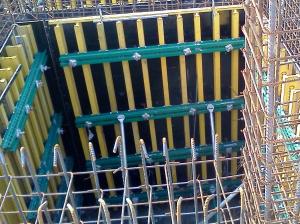Scaffolding Spigot Formwork Scaffolding For Painters High Quality
- Loading Port:
- Tianjin
- Payment Terms:
- TT OR LC
- Min Order Qty:
- 6000 set
- Supply Capability:
- 50000 set/month
OKorder Service Pledge
OKorder Financial Service
You Might Also Like
Scaffolding Spigot Formwork Scaffolding For Painters High Quality
Cuplock Scaffolding For Sale Formwork Scaffolding Catwalk With Great Price
Plastic Formwork Concrete Formwork System New Design
Developing with new technology materials, steel formworks is no longer a must in construction concrete process. More and more buildings are established with plastic formworks. And workers love this new formworks much more.
All-Round Scaffolding System Formwork Ringlock Scaffolding System Made In China
The advantages of plastic formworks:
1.First of all--light
Yes it is the first advantage of plastic formwork. It wins the great praise of both contractors and workers.
The biggest panel is 120×1500px,weights 10.5kg only. It can be lift and set up by one person easily, which means there is no need for cranes on site.Saves a lot of cost and time.
2.Easy set up
Different size of panels can firmly locked by simply turn the special handles to 90 degree. The Panels has rib on the back, which makes the system need not traditional wood blocks and nails. The panels have holes to fit tie rod, guarantee the strength of the whole system.
3.Modularity
Modular formworks composed by different size of panels,the main item is 120×1500px panel,which is used for the large area of walls and slabs. There are also small size of panels like 10×1500px,20×1500pxcm,25×1500px,inner corner 20×20×1500px and outer corner 10×5×1500px.Due to the variety of panel size, the system can form almost all size walls 120×1500px panel of multiply by 125px. The material of modular formwork is PC-ABS mixed with special glass fibers which enable panels to hold high pressures.
4.Strength
The handles are made by high strength Nilon, each panel locked by at least 4 handles, which makes the whole system strong enough to pour 1000px walls.
5.Environment friendly
The system needs no cut and nail due to the variety size. Also it needs nearly no wood. The material can be recycled after broken, so it will not pollute the environment.
6.Consequent
Concrete does not stick to plastic formwork, thus the panels need no oil before using, and can be cleaned simply by water. The surface of the wall which build by modular formwork is smooth and without rework.
Scaffolding Spigot Formwork Scaffolding For Painters High Quality
Scaffolding Spigot Formwork Scaffolding For Painters High Quality
Scaffolding Spigot Formwork Scaffolding For Painters High Quality
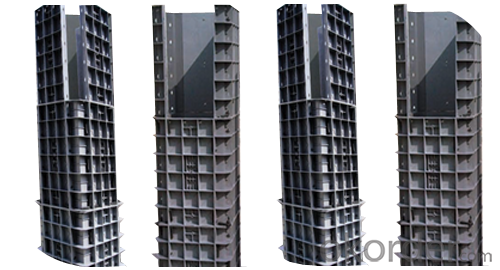
Advantage
* Good loading capacity
* Easy to assemble and dismantle
* Customized solution helps you work safe, save cost and convenient
* Excellent quality for formwork & scaffolding with wide choices
Packing
in bulk or in bundle, or as requested
Shipping
15-20 Days.
Normally small orders, it needs just 15-20 business days to the port. For goods with stock, it would be even shoter.
Scaffolding Spigot Formwork Scaffolding For Painters High Quality
Other scaffolding & formwork products:
(1) Scaffolding System:
Including Ringlock Scaffolding System and accessories; Cuplock Scaffolding System and accessories; Kwikstage Scaffolding System and accessories; Haki Scaffolding System and accessories;
(2) Scaffolding Frame & Accessories:
Including Walk Through Frame Scaffolding; Ladder Frame Scaffolding; Accessories; we also can make scaffolding according to your samples or drawings.
(3) Scaffolding Couplers/Clamps
(4) Formwork System Scaffolding & Accessories
FAQ AScaffolding Spigot Formwork Scaffolding For Painters High Quality
Why Us?
We are one of the Top 500 in the world, largest construction materials supplier in China. Also we are a state-owned company and respond to every customer with large and also small orders.
Excellent products with competitive prices.
Efficient services in pre and after sale.
Full energy with affluent experience team.
- Q: Does steel frame formwork require any specific concrete pouring techniques?
- Yes, steel frame formwork does require specific concrete pouring techniques. This is because the steel frame formwork system is designed to provide support and structure during the pouring and curing of concrete. Firstly, it is important to ensure that the formwork is properly aligned and secured before pouring the concrete. This will help to prevent any leakage or distortion during the pouring process. The formwork should be checked for any gaps or spaces that may cause concrete to seep through. Secondly, the concrete pouring technique should be carefully planned to ensure uniform distribution and consolidation of the concrete within the formwork. This can be achieved by using appropriate pouring methods such as the continuous pour, where the concrete is poured continuously in a single operation, or the layer-by-layer pour, where the concrete is poured in multiple layers and compacted in between. Additionally, it is important to use appropriate vibration techniques to eliminate air pockets and ensure proper compaction of the concrete. Vibrators can be used to achieve this, either by hand-held or mechanical methods, depending on the size and complexity of the formwork. Furthermore, proper curing techniques should be employed to facilitate the hardening and strength development of the concrete. This can involve measures such as covering the formwork with a curing membrane or applying a curing compound to maintain moisture and temperature levels. In summary, steel frame formwork does require specific concrete pouring techniques to ensure the structural integrity and quality of the finished concrete structure. Proper alignment, uniform pouring, compaction, and curing techniques are essential for achieving the desired results.
- Q: What types of concrete structures can be built using steel frame formwork?
- Steel frame formwork is versatile and can be used to build a wide range of concrete structures. Some examples include high-rise buildings, bridges, tunnels, dams, and even complex architectural designs. The steel frame provides the necessary support and stability during the pouring and curing process, enabling the construction of durable and robust concrete structures.
- Q: How does steel frame formwork help in achieving a high-quality concrete finish?
- Steel frame formwork helps in achieving a high-quality concrete finish by providing a strong and sturdy structure that holds the concrete in place during the pouring and curing process. This formwork system ensures uniformity and accuracy in the shape and dimensions of the concrete structure, resulting in a smooth and even finish. Additionally, the steel frame formwork allows for easy removal and reusability, facilitating efficient construction and reducing material waste.
- Q: Can steel frame formwork be used in projects with limited access to construction equipment?
- Construction projects with limited access to construction equipment can utilize steel frame formwork. This system is both versatile and durable, offering easy assembly and dismantling. Unlike other methods, it does not require heavy machinery or specialized equipment for installation. Instead, a small team of workers can manually handle the steel frames. Even in areas with restricted access, the lightweight steel frames can be transported to the project site without difficulty. They can be swiftly set up and adjusted, ensuring efficient construction progress. Furthermore, the frames can be reused multiple times, making them an economical choice for projects with limited access to construction equipment. In conclusion, steel frame formwork presents a practical and feasible solution for construction projects with restricted access to construction equipment. This enables the implementation of efficient and effective construction processes.
- Q: How does steel frame formwork handle the placement of retaining walls and earthworks within the concrete structure?
- The utilization of steel frame formwork is an adaptable and effective approach for managing the positioning of retaining walls and earthworks in a concrete structure. This method involves the use of steel frames that are easily adjustable and can be tailored to meet the specific requirements of the project. In relation to retaining walls, steel frame formwork offers a robust and long-lasting support system. The design of the steel frames is intended to withstand the pressure exerted by the soil and provide stability during the process of pouring and curing the concrete. This guarantees that the retaining wall can endure lateral forces and maintain its shape and integrity over time. Furthermore, steel frame formwork enables flexibility in the design and construction of retaining walls. The frames can be effortlessly modified to accommodate varying heights and slopes, allowing for the creation of walls with different inclinations. This is particularly advantageous in situations where the retaining wall needs to be constructed on uneven terrain or where specific architectural or engineering requirements are present. Regarding earthworks, steel frame formwork provides a secure and stable platform for placing the concrete. The frames are designed to support the weight of the concrete and provide a level surface for pouring and spreading the material. This ensures that the concrete is evenly distributed and properly compacted, resulting in a durable and resilient structure. Moreover, steel frame formwork facilitates efficient and cost-effective construction of earthworks. The frames can be easily assembled and disassembled, making them ideal for projects that require frequent repositioning or where time is of the essence. Additionally, the steel frames can be reused multiple times, reducing the need for excessive materials and minimizing waste. Overall, steel frame formwork is a dependable and efficient method for managing the placement of retaining walls and earthworks in a concrete structure. Its strength, flexibility, and cost-effectiveness make it a preferred choice for numerous construction projects.
- Q: How does steel frame formwork compare to timber formwork in terms of cost?
- In terms of cost, steel frame formwork generally tends to be more expensive compared to timber formwork. This is mainly due to the higher material and manufacturing costs associated with steel. Steel frame formwork requires the use of steel beams, panels, and other components, which are typically more expensive than timber materials. Additionally, constructing steel formwork requires specialized skills and equipment, which can further increase the overall cost. On the other hand, timber formwork is relatively more affordable as timber materials are generally cheaper and readily available. However, it is important to note that despite its initial higher cost, steel frame formwork offers several advantages that can contribute to cost savings in the long run. Steel formwork is more durable and has a longer lifespan compared to timber formwork, which can result in reduced maintenance and replacement costs over time. Moreover, the reusability of steel formwork is another cost-saving factor. Steel frames can be easily dismantled, transported, and reused for multiple construction projects, whereas timber formwork may need to be replaced after a few uses due to wear and tear. Ultimately, when considering the cost of formwork, it is essential to evaluate the specific needs and requirements of the project, as well as the expected lifespan and potential for reuse. While steel frame formwork may initially have a higher price tag, its durability and reusability can make it a more cost-effective choice in the long term, particularly for larger or repetitive projects. Conversely, timber formwork may be more suitable for smaller or one-time projects where cost efficiency is a primary concern.
- Q: Can steel frame formwork be used for inclined or sloped concrete structures?
- Yes, steel frame formwork can be used for inclined or sloped concrete structures. Steel frame formwork is a versatile and flexible system that can be adjusted and customized to meet the specific requirements of inclined or sloped structures. This system comprises steel frames, typically made of steel tubes, which are interconnected to create a robust structure. The frames can be easily adjusted to form the desired shape and angle for inclined or sloped concrete structures. Moreover, steel frame formwork offers several advantages in such applications. Firstly, the steel frames provide excellent strength and stability, ensuring that the formwork can withstand the pressure of the concrete during pouring and curing. Additionally, the steel frames can be easily dismantled and reassembled, allowing for efficient and cost-effective use on multiple projects. Furthermore, steel frame formwork can be combined with other components such as plywood or steel panels to create a complete system that can support the weight of the concrete and provide a smooth and even surface finish. This versatility and adaptability make steel frame formwork an ideal choice for inclined or sloped concrete structures, as it can easily accommodate the unique requirements and specifications of such projects. In conclusion, steel frame formwork can indeed be used for inclined or sloped concrete structures, offering strength, flexibility, and efficiency in construction.
- Q: Airtight door and all glass steel frame door which cost is high
- It should be airtight door, somehow there are some technical content
- Q: How does steel frame formwork contribute to better concrete consolidation?
- Steel frame formwork contributes to better concrete consolidation in several ways. Firstly, the steel frame provides a rigid structure which ensures that the formwork remains in place during the pouring and curing process. This stability prevents any movement or deformation of the formwork, allowing the concrete to settle and consolidate properly. Secondly, steel frame formwork is designed with built-in vibrators or vibratory systems. These vibrators are strategically placed along the formwork to help distribute the concrete evenly and remove any air pockets or voids. The vibration action also helps to compact the concrete, improving its strength and durability. Furthermore, the steel frame formwork allows for easy and precise placement of reinforcement bars or mesh within the formwork. This ensures that the reinforcement is properly embedded within the concrete, enhancing its structural integrity and preventing any potential cracks or failures. Additionally, steel frame formwork provides a smooth and uniform surface for the concrete. This smooth finish allows for better adhesion between the concrete and any subsequent layers or finishes, such as plaster or paint. It also reduces the need for additional surface treatments, saving time and costs. Overall, the use of steel frame formwork greatly enhances the consolidation of concrete by providing stability, facilitating vibration, ensuring proper reinforcement placement, and creating a smooth finish. These factors contribute to the production of high-quality and durable concrete structures.
- Q: How does steel frame formwork ensure proper alignment of columns and beams?
- The rigid and accurate construction of steel frame formwork ensures the proper alignment of columns and beams. The steel frame is precisely designed and manufactured to create a strong and stable structure for the formwork system. To begin with, the steel frame formwork is specifically designed to perfectly fit around the columns and beams, ensuring a tight and secure fit. This prevents any movement or shifting while pouring and curing the concrete. The formwork is typically adjustable, allowing for easy alignment of the columns and beams to the desired position. This adjustability enables the formwork to accommodate different sizes and shapes of columns and beams. Furthermore, the steel frame formwork provides a level and even surface for pouring concrete. The formwork is usually equipped with adjustable metal props or jacks, allowing for precise adjustment of the height and level of the columns and beams. This ensures that the concrete is poured onto a level surface, preventing any unevenness or sloping in the final structure. In addition, the steel frame formwork is designed to withstand the pressure and weight of the concrete during the pouring process. The steel frame is constructed with strong and durable materials, guaranteeing that it can support the weight of the concrete without any deformation or movement. This stability and rigidity of the formwork prevent any misalignment or distortion of the columns and beams. In summary, the steel frame formwork system guarantees the proper alignment of columns and beams by providing a rigid, adjustable, and level structure for pouring concrete. It ensures accurate positioning of the columns and beams, resulting in a structurally sound and aesthetically pleasing final construction.
Send your message to us
Scaffolding Spigot Formwork Scaffolding For Painters High Quality
- Loading Port:
- Tianjin
- Payment Terms:
- TT OR LC
- Min Order Qty:
- 6000 set
- Supply Capability:
- 50000 set/month
OKorder Service Pledge
OKorder Financial Service
Similar products
Hot products
Hot Searches
Related keywords
